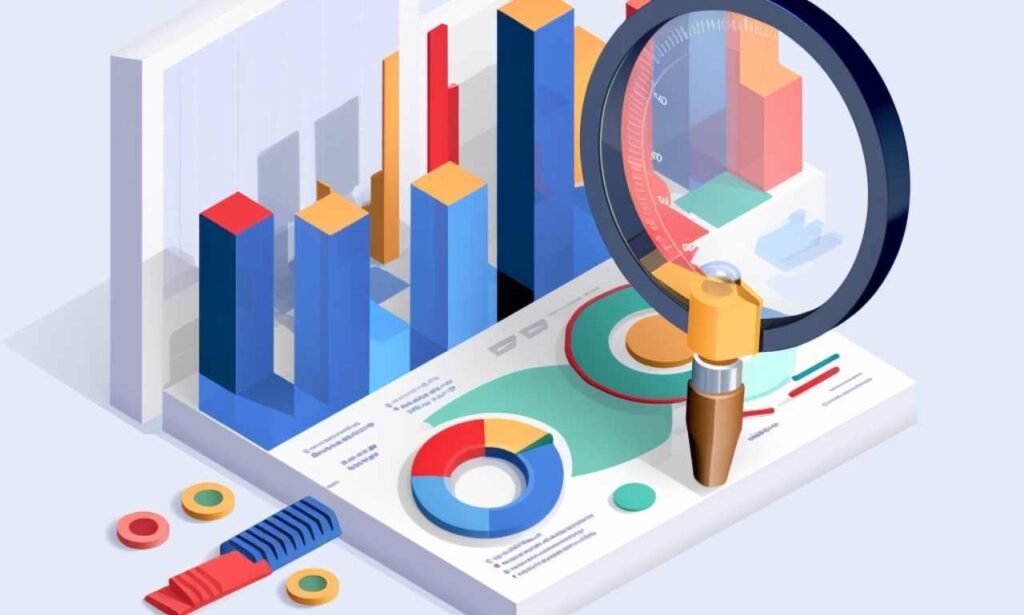Imagine having the power to predict your customers’ needs, tailor your marketing strategies to their preferences, and create a seamless online shopping experience that skyrockets your sales. It sounds like a dream come true, right? Well, buckle up because analytics for ecommerce site is the key that unlocks this treasure trove of insights. Ultimately granting you the freedom to make data-driven decisions and elevate your business to new heights.
In today’s fast-paced digital world, harnessing the power of e-commerce analytics is no longer a luxury; it’s an absolute necessity. By tracking essential metrics and analyzing customer behavior, you can gain invaluable insights into what makes your audience tick. Empowering you to optimize every aspect of your online store for maximum impact. So get ready to dive into the captivating world of e-commerce analytics and set yourself free from the constraints of guesswork and intuition. Embrace a future where data-driven decisions reign supreme!
Table of Contents
ToggleKey Takeaways
- E-commerce analytics is essential for understanding customers and optimizing online business performance.
- Key metrics include conversion optimization, average customer order value, and bounce rate analysis.
- Analyzing customer behavior involves focusing on CLV and retention rate to understand shopping habits and preferences.
- Utilizing analytics tools can identify areas for improvement and boost sales and customer satisfaction.
Importance of Analytics for Ecommerce Site

You can’t underestimate the importance of analytics for ecommerce site. As it’s crucial for understanding your customers and optimizing your online store’s performance. By leveraging data-driven insights, you can make better decisions that increase sales, improve customer satisfaction, and, ultimately, more freedom in your business pursuits. With e-commerce forecasting and analytics personalization at your fingertips, you have the power to unlock new avenues for growth and success in the ever-evolving world of online retail.
Imagine being able to predict trends before they take off or tailor your marketing efforts specifically to each customer. These are just a few examples of what analytics for ecommerce site can do for you. As an online entrepreneur seeking creative ways to thrive in today’s competitive landscape. Embracing analytics is like having a crystal ball that helps you see your business’s future. With valuable insights into how customers interact with your brand. You’ll be better equipped to create personalized shopping experiences that turn one-time visitors into loyal fans.
Don’t miss out on harnessing the full potential of analytics for ecommerce site by focusing only on surface-level metrics. Delve deeper into key performance indicators (KPIs) that truly matter for driving sustainable growth. In the next section, we will dive into some essential metrics that will help propel your online store toward tremendous success by enabling more intelligent decision-making and targeted marketing business strategies. So go ahead – unleash the power of data-driven insights and watch as newfound freedom blooms within your digital empire!
Key Metrics to Track

By closely monitoring key metrics, it’s easier to make data-driven decisions that help grow your online store. With the freedom to pivot and adjust strategies based on real-time information. You can maximize your e-commerce success and stay ahead of the competition. To achieve this level of control, focus on e-commerce tracking by analytics for ecommerce site. These three critical metrics should be considered:
- Conversion optimization: This metric measures how effectively your website persuades visitors to complete a desired action (i.e., purchasing). By improving sales conversion rates, you’re directly increasing revenue without investing in acquiring more traffic.
- Average order value (AOV): AOV is an essential indicator of how much revenue each transaction generates. Boosting AOV means customers purchase more expensive items or add additional popular products to their cart. Both actions positively contribute to your bottom line.
- Bounce rate analysis: This metric reveals the percentage of customers who leave your site after viewing only one page without taking any further action. A high bounce rate could signal issues with user experience or content relevancy.
Armed with this knowledge, you have the power to create a thriving online store. That gives you unparalleled freedom and independence from traditional retail limitations. Every tweak and improvement based on these metrics will bring you closer to providing an exceptional customer experience. That keeps them returning for more.
Remember that understanding customer behavior goes beyond just numbers. It’s about identifying patterns and trends among those who visit your site regularly. Once you’ve mastered tracking these key metrics, continue exploring ways to analyze customer shopping behavior. Doing so will unlock even more excellent opportunities for growth and success in e-commerce.
Analyzing Customer Behavior/Analytics for Ecommerce Site

Unlock your e-commerce site’s full potential by diving deep into user behavior analysis. Focus on critical metrics like Customer Lifetime Value (CLV) and Retention Rate to better understand their shopping habits. And preferences and ultimately boost revenue. By continuously refining your marketing strategies based on these insights. You’ll drive repeat business and foster long-lasting relationships with your customers.
Customer Lifetime Value
With customer lifetime value. It’s like peering into a crystal ball that reveals how much profit each client brings over their entire relationship with your brand. By maximizing CLV, you’ll gain a deeper understanding of your customers and be able to adopt value-based marketing strategies that fuel their desire for freedom. Imagine the possibilities: -Tailoring exclusive offers and experiences that resonate with their unique needs – Crafting personalized content to inspire and engage them at every touchpoint – Empowering them through loyalty programs, giving them the autonomy to choose rewards they genuinely want
A strong focus on increasing customer lifetime value is essential for long-term success in eCommerce. When you know which clients are worth investing in. You can allocate resources more effectively and create lasting relationships that lead to repeat purchases. This approach goes hand-in-hand with improving retention rates – keeping existing customers engaged and returning for more. As you unlock the secrets of your customers’ behavior patterns, you’ll discover new ways to make them feel valued and accessible – creating an unbreakable bond between them and your brand. So get ready to dive deep into the world of retention rate analysis. And unearth valuable insights that will transform your business growth trajectory.
Retention Rate
Focusing on the retention rate is a crucial aspect of your eCommerce strategy. As it helps you understand how well you’re keeping customers engaged and coming back for more. Implementing effective retention strategies and churn prevention tactics ensures that your hard-earned customers stay loyal to your brand. And contribute to an overall increase in revenue. Imagine the sense of freedom when you see those repeat purchases rolling in. Knowing your business is growing without constantly chasing new leads.
To improve your retention rate, start by analyzing customer behavior data and identifying patterns that could indicate dissatisfaction or disengagement. Then, develop personalized marketing campaigns tailored to re-engage individual customers based on their unique preferences and needs. By showing them that you genuinely care about their experience with your brand. You can create a connection that keeps them returning for more. Remember, it’s not just about acquiring new customers. It’s about nurturing existing ones to ensure they stay with you for the long haul. Now that you’ve got a grip on customer lifetime value and retention rate. It’s time to dive into the world of analytics tools to optimize your eCommerce platform’s success truly.
Utilizing Analytics Tools

By leveraging analytics for ecommerce site. You’ll gain valuable insights into your eCommerce store’s performance and identify areas for improvement to boost company sales and customer satisfaction. Driving conversions and optimizing user experience are essential to a successful online business. With the right analytics tools, you can easily track various aspects of your website. Such as visitor behavior, conversion rates, and overall revenue.
- Analyze customer behavior: Understanding how customers interact with your website will help you make informed decisions on improving site layout, product offerings, and email marketing strategies.
- Monitor key performance indicators (KPIs): Keep an eye on important metrics like average order value (AOV), customer lifetime value (CLV), and shopping cart abandonment rate to ensure steady growth.
- Identify trends and patterns: Stay ahead of the competition by analyzing data over time to spot emerging trends or potential problems before they impact your bottom line.
As you become more proficient in utilizing analytics for ecommerce site. You’ll be empowered to make data-driven decisions that lead to increased revenue and happier customers. Remember that embracing these actionable insights is about more than just increasing profits – it’s about gaining the freedom to focus on what truly matters. Creating memorable experiences for your potential customers that keep them coming back for more. So go ahead, and harness the power of analytics today for a brighter tomorrow. Where success is driven by your ability to adapt quickly based on factual information. And now that you’re armed with powerful knowledge about leveraging these tools effectively let’s explore how making data-driven decisions can further propel your eCommerce store towards success.
Making Data-Driven Decisions

Ready to level up your e-commerce game? Start by identifying trends in your analytics data and harness the power of making data-driven decisions. Utilize these insights to implement strategic changes that drive continuous improvement, fuel growth, and propel your business forward.
Check out about 15 Hypergrowth AI Strategies
Identifying Trends
Keeping an eye on emerging trends in eCommerce business analytics is crucial to staying ahead of the competition and optimizing your online store’s performance. By leveraging trend forecasting and pattern recognition, you can identify shifts in consumer behavior, preferences, and market dynamics that could impact your business. This foresight allows you to pivot swiftly and position yourself as a leader rather than a follower.
- Monitor loyal customer feedback: Pay close attention to reviews, comments, and social media sentiments to pinpoint what customers praise or complain about. This will help you make any improvements that are needed.
- Track industry news: Stay informed on developments within your niche by following industry blogs, attending conferences, or joining relevant forums or groups.
- Analyze competitors: Keep tabs on what other successful businesses in your space are doing – their successes (and failures) can provide valuable business insights for your strategy.
- Utilize data visualization tools: These tools can help you spot patterns and correlations more efficiently to act quickly on the information.
By proactively identifying trends, you’ll stay ahead of the curve and maintain control over your success—an essential component for anyone seeking freedom through entrepreneurship. Now that we’ve discussed spotting trends let’s delve into how best to implement changes for improvement within your online store operations.
Implementing Changes for Improvement
So, you’ve identified some trends and areas for growth. Now it’s time to make those crucial changes to boost your online store’s performance. Implementing changes for improvement is all about optimizing conversions and streamlining operations. It’s about taking charge of your digital destiny and creating an online shopping experience that meets and exceeds customer expectations. By tweaking product pages, simplifying checkout processes, and utilizing data-driven marketing strategies, you’ll be well on your way to transforming your E-COMMERCE companies into an unstoppable force.
Don’t just sit back and let fate decide the future of your online store. Seize control by actively making improvements based on the trends you’ve discovered. Capitalize on newfound opportunities by revamping email campaigns, refining product offerings, or reimagining user interfaces – whatever it takes to elevate your brand in the eyes of consumers. As a result, watch sales soar, customers rave about their personalized experiences, and a sense of true freedom washes over you – because nothing feels better than knowing that the success of your e-commerce website lies entirely in your capable hands.
Ecommerce Analytics: The Definitive Guide
Various data sources, including e-commerce online sales data, Search engines Analytics, online consumer surveys, email open rates, Excel worksheets, and even paper-based forms, are all essential components of the data collection process.
All types of data repositories, such as e-commerce sales data, online consumer surveys, Google Analytics, email open rates, and Excel worksheets, should be considered when collecting relevant information.
The data collected includes information from various sources such as Shopify, Magento, Facebook, Google Ads, Instagram, Google Analytics Enhanced Ecommerce, CRM platforms, social media posts, and email providers.
The data collected includes information from various sources such as Shopify, Magento, Facebook and Google Ads, Instagram, Google Analytics Enhanced Ecommerce, CRM platforms, and email providers.
To consolidate your data, utilizing a centralized platform such as Google Analytics or more advanced tools like Triple Whale is recommended. A centralized platform like Google Analytics or more advanced tools like Triple Whale is recommended.
To centralize your data, using a platform such as Google Analytics or more advanced options like Triple Whale is recommended.
Analyzing demographic data, such as age, gender, and geographic location, provided by Google Analytics can provide insights into your brand’s awareness. This knowledge can inform decisions about investing more in paid ads and organic marketing channels.
Utilizing demographic data such as age, gender, and geographic location from the Google Analytics platform can provide insight into brand awareness and inform decisions regarding investment in paid ads and organic marketing strategies.
